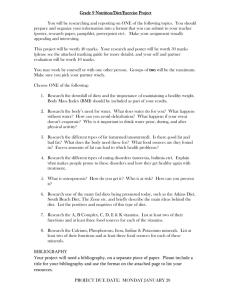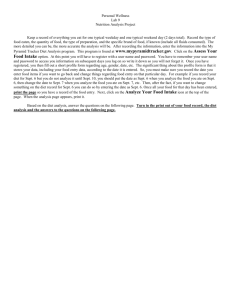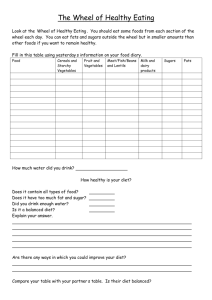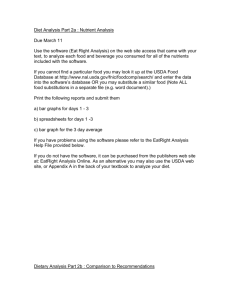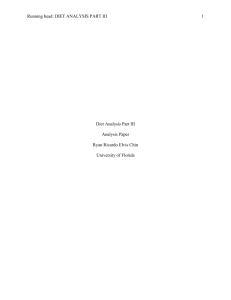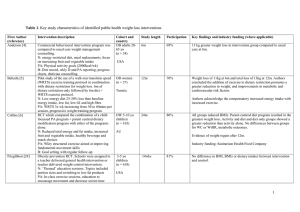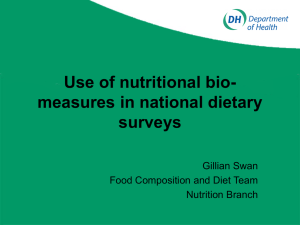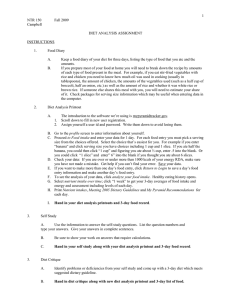Diet, Nutrition, and Cancer
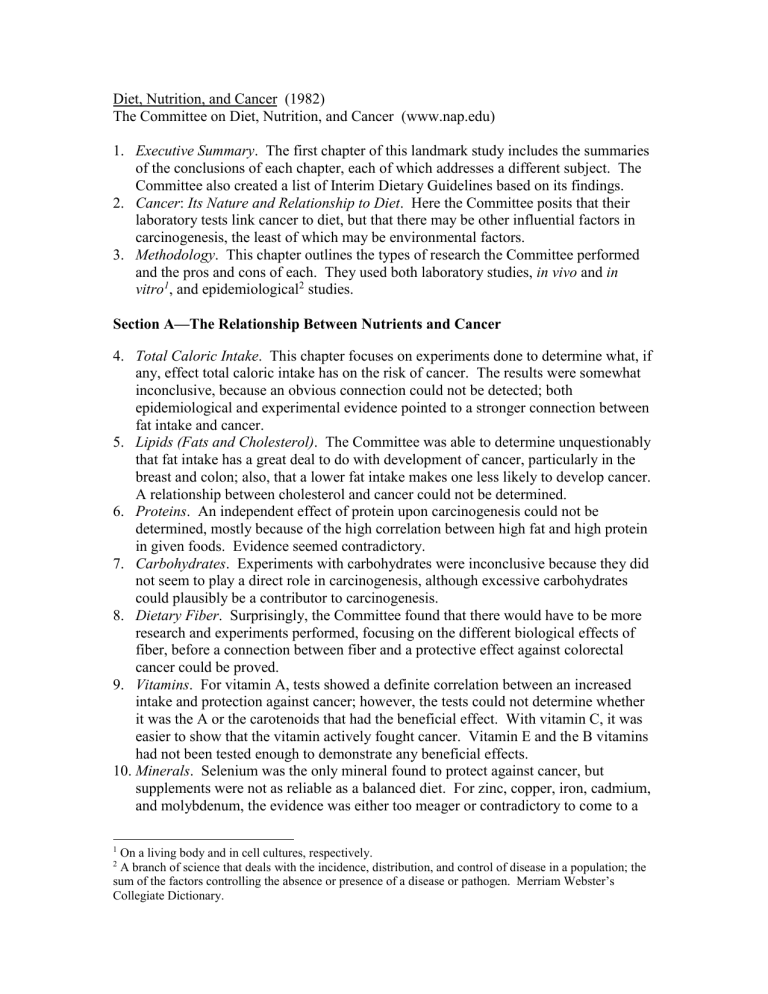
Diet, Nutrition, and Cancer (1982)
The Committee on Diet, Nutrition, and Cancer (www.nap.edu)
1.
Executive Summary . The first chapter of this landmark study includes the summaries of the conclusions of each chapter, each of which addresses a different subject. The
Committee also created a list of Interim Dietary Guidelines based on its findings.
2.
Cancer : Its Nature and Relationship to Diet . Here the Committee posits that their laboratory tests link cancer to diet, but that there may be other influential factors in carcinogenesis, the least of which may be environmental factors.
3.
Methodology . This chapter outlines the types of research the Committee performed and the pros and cons of each. They used both laboratory studies, in vivo and in vitro
1
, and epidemiological
2
studies.
Section A—The Relationship Between Nutrients and Cancer
4.
Total Caloric Intake . This chapter focuses on experiments done to determine what, if any, effect total caloric intake has on the risk of cancer. The results were somewhat inconclusive, because an obvious connection could not be detected; both epidemiological and experimental evidence pointed to a stronger connection between fat intake and cancer.
5.
Lipids (Fats and Cholesterol) . The Committee was able to determine unquestionably that fat intake has a great deal to do with development of cancer, particularly in the breast and colon; also, that a lower fat intake makes one less likely to develop cancer.
A relationship between cholesterol and cancer could not be determined.
6.
Proteins . An independent effect of protein upon carcinogenesis could not be determined, mostly because of the high correlation between high fat and high protein in given foods. Evidence seemed contradictory.
7.
Carbohydrates . Experiments with carbohydrates were inconclusive because they did not seem to play a direct role in carcinogenesis, although excessive carbohydrates could plausibly be a contributor to carcinogenesis.
8.
Dietary Fiber . Surprisingly, the Committee found that there would have to be more research and experiments performed, focusing on the different biological effects of fiber, before a connection between fiber and a protective effect against colorectal cancer could be proved.
9.
Vitamins . For vitamin A, tests showed a definite correlation between an increased intake and protection against cancer; however, the tests could not determine whether it was the A or the carotenoids that had the beneficial effect. With vitamin C, it was easier to show that the vitamin actively fought cancer. Vitamin E and the B vitamins had not been tested enough to demonstrate any beneficial effects.
10.
Minerals . Selenium was the only mineral found to protect against cancer, but supplements were not as reliable as a balanced diet. For zinc, copper, iron, cadmium, and molybdenum, the evidence was either too meager or contradictory to come to a
1 On a living body and in cell cultures, respectively.
2 A branch of science that deals with the incidence, distribution, and control of disease in a population; the sum of the factors controlling the absence or presence of a disease or pathogen. Merriam Webster’s
Collegiate Dictionary.
conclusion. Only an iron deficiency, arsenic, and lead were shown to have links to cancer.
11.
Alcohol . The Committee found that excessive ingestion of alcohol was linked to cirrhosis and hepatic injury, and that smoking and drinking together acts to increase cancer of the mouth, larynx, esophagus, and the respiratory tract.
Section B—The Role of Non-nutritive Dietary Constituents
12.
Naturally Occurring Carcinogens.
The findings for mycotoxins, hydrazines, alkaloids, and cyasin, among others, were that these elements have been known to cause cancer in animals, and may therefore pose a threat to humans. The Committee called for more research concerning human reactions.
13.
Mutagens in Food.
Too many mutagens
3
had not been tested for carcinogenicity, and those that had been tested showed conflicting results. Their danger as opposed to their relative inoffensiveness could not be proved.
4
14.
Additives and Contaminants.
Of the food additives and environmental contaminants detected in food, many have already been tested for carcinogenecity, and those that have tested positive have been banned from the food supply. However, the fact that untested chemicals are still being added is enough to warrant further research.
15.
Inhibitors of Carcinogenesis.
The Committee found that there is reason to believe that certain vegetables do inhibit cancer, specifically cruciferous and carotene-rich vegetables. At the time of study, however, scientists had not determined which agent in these vegetables prevented cancer.
Section C—Patterns of Diet and Cancer
16.
The Relationship of Diet to Cancer at Specific Sites . Prostate and breast cancer specifically can be linked to a higher fat and protein intake; inversely, diets high in vitamin A (or vegetarian diets) are associated with a lower risk.
17.
Assessment of Risk to Human Health . According to many studies recent to the publication of DNC, it was obvious the diet had some connection to incidence of cancer, but the Committee was unable to determine to what degree. Also in question was how much a change in diet could decrease the risk of cancer.
In 1982, the medical world was only beginning to scratch the surface of the study of cancer-affecting diets. This one study began a movement to pin down the real causes of cancer and attempt to halt its progression through a balanced diet. The study is surprisingly readable, and even pleasantly dense, because the medical jargon is presented in such a way as to be discernable through context. The organization of the text is easy to work with because information is grouped under helpful headings and is summarized after every chapter and sometimes after every section. Perhaps the more pertinent significance for this text twenty years later is that it opened up the door to further
3 An agent that tends to increase the frequency or extent of mutation. Merriam Webster’s Collegiate
Dictionary.
4 “…cooking of meat and fish produces mutagens, but it also destroys pathogenic microorganisms and parasites. Furthermore, some foods contain mutagenic flavonoids but also have high nutritional value.”
DNC.
research. The Committee could not, at that time, make certain connections that we now know more about, and so made a call for further investigation. Also noteworthy are the many clues left to us by the Committee, who did not possess the technology to test some of their ideas but had a hunch that this or that might contribute to the development of cancer. (For example, that nutrients and nonnutritive elements in cruciferous and carotene-rich vegetables also inhibited carcinogenesis. Which ones could not be determined.) Also important are the Committee’s few mistakes. For example, this quote from the study: “Apart from cigarettes, the causes of most of today’s cancers do not bear any simple and direct relationship to the intended and unintended products of industry and to what might be called the more unnatural features of modern life. This is not to say that industrial exposure is harmless, but simply that relatively few of the middle-aged and older members of our current population have been exposed to great occupational hazards” (23). If only that were true! Overall, this study proved an invaluable and rich resource for the advancement of cancer research, and therefore is an essential part of what is shaping up to be a dietary renaissance.
DO:
Reduce intake of saturated and unsaturated fats.
Include fruits, vegetables, and whole grains in your daily diet.
DON’T:
Eat pickled, smoked, or salt-cured foods.
Consume alcohol in excess.
Other Recommendations of the Committee:
Continue to study food additives to determine their pros and cons before putting them into the food supply.
Continue to identify and remove mutagens in foods.



